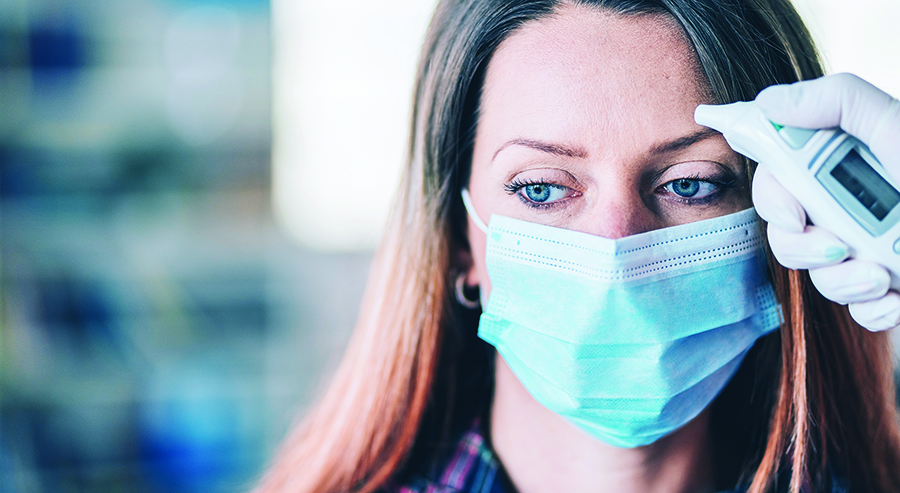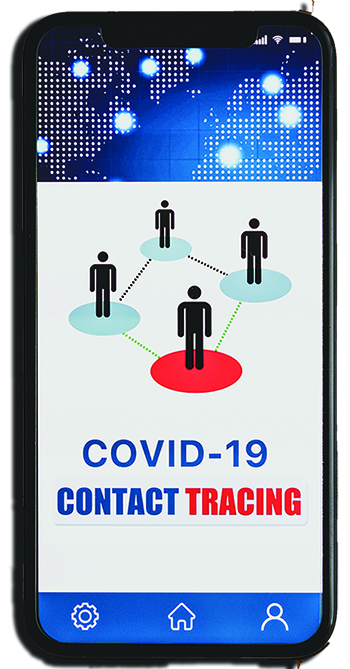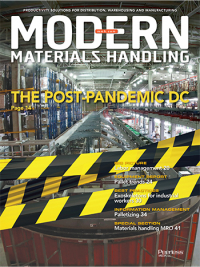The Post-Pandemic Distribution Center
As the economy begins to recover, distribution center operators will be challenged with not just operating efficiently, but safely. Emerging technologies may aid in the effort.
In mid-April, Bloomberg reported that a dozen workers at a Ford plant in Plymouth, Mich., were “experimenting with wearable social distancing devices that could be deployed more widely once the car maker reopens idled manufacturing plants.” The smart watches, a joint effort between Samsung Electronics and Radiant RFID, use Bluetooth technology “to detect proximity and clustering of workers.”
If two people are standing too close to one another, the watch vibrates and displays a color-coded, “danger Will Robinson” warning that tells them to break it up. Ford also announced that it expects to use thermal-imaging scanning technology as workers enter a facility to look for fever, and to provide workers with masks and plastic face shields.
Welcome to the post-Covid-19 industrial workplace. While companies are wrestling with the question of when to re-open shuttered factories and distribution centers that were not deemed essential, the even bigger question is how to operate those facilities going forward. Very narrow aisle could take on a whole new meaning.
Our industry has always looked for solutions to operate in an efficient and cost-effective way; now, it will also struggle with new issues related to preventing the spread of a virus—either Covid-19, or whatever is around the bend. They will largely be on their own: As of this writing, the CDC guidelines for re-opening businesses were polite suggestions, not prescriptions. What’s more, while we know lawsuits will be filed by employees who test positive for the virus after we all return to work, we don’t yet know whether those claims will be governed by OSHA and worker compensation or the courts. The message is essentially:
Get back to work, and good luck.
If there is light at the end of the tunnel, it’s that some potential solutions are coming to market from materials handling technology providers. Make no mistake: This is an emerging area, and there’s no guarantee any of these solutions will create the bullet-proof, safe operating environment we will all strive for. Nor is this a comprehensive list: New emails are showing up in our inbox daily. But, the following companies are developing solutions for plants and DCs around screening, workplace social distancing and finally, contact tracing should an associate test positive. They, or their competitors, may be worth investigating as you look to create your own safe working environment.

Screening
Ford is not alone in pursuing thermal image scanning to check the temperatures of its workers as one tell-tale sign of the presence of an infection. Known as human fever detection systems, the devices use technology developed for the thermal weapon sights attached to military weapons like the M16 rifle, according to Steve McHugh, president of Santa Barbara Infrared Inc.
SBIR designs and manufactures infrared and electro-optical test instrumentation that is integrated into thermal image scanning systems; they don’t provide the scanner, but the thermal reference the scanner uses to compare to the person being scanned. McHugh is seeing a lot of activity right now among companies making scanning systems.
Many of those systems will go into initiatives like airport screening, retail establishments, and restaurants and office buildings, but industrial settings won’t be far behind. “There are a couple of companies looking at installing thermal cameras in warehouses to see if you can identify temperature spikes in an individual,” notes Dani Bradnan, a research associate with Lux Research. Early adopters are primarily in Asia, she adds.
Bradnan’s current focus is the use of wearable technologies to capture health markers for telemedicine. However, some solutions under development might find their way into the industrial workplace. Examples include a wearable wrist band that would identify whether you have been tested for Covid-19; another is a Bluetooth app installed on your phone that identifies and stores information on any Bluetooth-enabled phone you come in contact with in the previous 21 days.
If that technology was deployed throughout a distribution center, and an associate came down with the virus, there would be a record of everyone in the facility the infected individual had come in recent contact with. Other technologies in development include a wrist band with thermal monitoring capabilities.
“It’s nascent, but there are a lot of startups working on these issues,” Bradnan says. “There are things that are within our grasp in a few years, providing regulation doesn’t slow us down.”
Create a checklist
A first step to a safer workplace is to create basic processes around cleaning, disinfecting, scheduling and, perhaps most importantly, what to do if an associate tests positive. Michael Wohlwend, managing principal with Alpine Supply Chain Solutions, relates the story of a client who had to shut down a warehouse for two weeks following a positive Covid case. “While they were cleaning and sanitizing the facility, every team leader was on the phone with suggestions for new procedures that would give the team the confidence to come back to work,” Wohlwend recalls. “It was a real wake up call.”
Just as important as the new procedures, which might vary from one facility to the next, is the ability to enforce them and demonstrate that they were followed if needed. To that end, Alpine worked with Procurant, a California-based technology company, to develop a phone app for auditing workplace procedures. It is created on a Cloud-based food safety tool that Procurant developed for tracking and tracing in the agricultural supply chain.
“You can set up as many checklists as you need, and then create a time stamp when tasks are completed,” Wohlwend says. “At the end of the day, you can create reports of what was done, who did it, when they did it and any corrective actions that were taken.” Training videos can be accessed using the tool for easy access, and alerts can be e-mailed or texted to individuals who need to be contacted. “If a person tests positive, you now have a checklist of what you need to do, and you can produce an audit trail of what was done,” Wohlwend says.
Redesign the workflow
We’re all learning to social distance in our personal lives. We stand 6 feet apart in the grocery store and step out of the way when another individual is walking toward us on the sidewalk. That’s more difficult to do in a distribution center, especially when warehouse management systems and business rules were designed around maximizing throughput rather than minimizing human contact.
One possible solution is a warehouse management system from Locanis that uses an ultra-wideband, real-time locating system rather than bar code scanning to track activities and the location of inventory in the warehouse. Mobile assets, such as forklifts, automatic guided vehicles, robots, manual operators or even a person walking through the facility are outfitted with sensors or wearable devices that communicate their location in real time to within 10 centimeters across X, Y and Z axis. The system is sensitive enough to know whether an associate is standing up or laying down. With that level of accuracy, “the system knows the relationship of every tag in the facility,” says Bengt Tuner, Locanis’ president and CEO. “You can create geofencing around people and create warning systems on a tablet if people are too close.”
The system could also take social distancing or other business rules into consideration during task management. “If you’ve sent a lift truck into a certain aisle in a very narrow aisle storage area and we know that we can only have one truck in that aisle at a time, the system can wait until the first truck has moved out before sending the next one in,” Tuner says. “If you want to isolate a particular individual for some reason, the system could assign them tasks like truck loading where they wouldn’t come into contact with other associates.”
He added that one solution provider has developed UWB wearables for the sports world that can measure biometrics like the body temperature, blood pressure and heart rate of athletes. In the future, those could potentially be adapted to industrial settings, assuming they comply with privacy and data protection regulations.
It’s a legal matter
An employer may have to contend with a number of unanswered legal questions if an associate is diagnosed positive with coronavirus from workplace exposure.
Is it a worker compensation issue, like most other workplace injuries? Or, is there civil liability that will be settled through the courts? Who is responsible if a third party claims they were exposed at a company’s DC, say a truck driver who was exposed while making a delivery?
The truth is, like so much else related to Covid-19, the honest answer is that we don’t know. “We’re in uncharted waters,” says Jim Curtis, a Chicago-based lawyer with Seyfarth. “We’ve never faced an issue like this.”
The one thing we do know, he adds, is that “there’s going to be lots of litigation over this before it’s done. We’re spending a lot of time talking with our clients about the measures they have in place, and what they have not done that they should do.”
With that in mind, Curtis has a few recommendations anyone operating a DC should consider.
Follow the guidelines: Companies should look to see what has been recommended by a number of sources, including the CDC, OSHA, the World Health Organization and make sure it is in compliance with any state, county or city executive orders.
Enforce social distance at the workplace: If you’re going to continue operating, Curtis recommends that employees wear masks and maintain social distancing on the job.
Develop contact tracing procedures: By definition, the first confirmed case in a facility came from outside the four walls, but the second case could be because they came in contact with that other associate. “If you do contact tracing, you might be able to identify clusters that can be prevented,” Curtis says.
Concentrate on the low-hanging fruit: Based on what we know, and we’re learning more every day, the virus is passed through human contact. For that reason, Curtis recommends employers identify the areas where associates congregate and eliminate those.
“Do they congregate when they check in and check out at the end of the day?” he asks. “Where does everyone put their lunch or eat? Is there a locker room? Those are things you can control.” Similarly, redesign travel paths so order selectors don’t run into one another.
Seyfarth has developed a checklist for employers returning to business after the pandemic at here…
Autonomous mobile robot providers are also adding social distancing features to their solutions. inVia Robotics, for instance, recently announced that it had added features to its control system to proactively keep workers at a safe distance from one another and notify supervisors if that distance is breached. inVia’s 3-D warehouse simulation view can now include distance calculations on the location of labor within the warehouse. On the warehouse floor, the system can notify an associate on any smart device if they have moved out of a safe zone.
Similarly, 6 River Systems reports that its system can be adapted to use static zoning rules to ensure associates remain in a zone that conforms with a facility’s social distance rules, and limit the number of associates any one robot works with during a shift. As of this writing, the company’s engineers are making software changes to ensure that when robots “are engaged with associates, they follow social distancing protocols when coworkers do meet in picking aisles.”
Contact tracing
Cleaning, disinfecting and social distancing are important to put in place in a facility. But an associate might still become infected from contact outside of work. If so, how does a company identify other associates the infected employee may have come in contact with?
Those are solutions being worked on by other technology providers. Triax Technologies, for instance, has developed a proprietary mesh network system to host Internet of Things (IoT) devices in IT challenged environments. Tags that communicate their location are placed on medium to large pieces of equipment while associates are issued wearables mounted on a hardhat or a lanyard around their necks. The devices talk to one another and start beeping if two or more workers get too close to one another; the alert escalates to a siren if they fail to get away in a prescribed time.
 In addition, all interactions are logged. If an associate tests positive, an employer can identify everyone that associate interacted with in a five or six day period. “We can very quickly identify the individuals who are at high risk because they came in contact with that person and quarantine them, without losing the whole workforce,” says Ian Ouellette, Triax’s principal data scientist.
In addition, all interactions are logged. If an associate tests positive, an employer can identify everyone that associate interacted with in a five or six day period. “We can very quickly identify the individuals who are at high risk because they came in contact with that person and quarantine them, without losing the whole workforce,” says Ian Ouellette, Triax’s principal data scientist.
Locix, which uses WiFi technology for real-time location tracking, is exploring ways to utilize its solution for contact tracing. “One approach we’ve looked at is putting a tracker on employees’ phones,” says CEO Vik Pavate. “With information collected by the system, if there is a positive case, we can work backwards to know which workers during a shift that person came into contact with and where. We can not only quarantine the right associates, but we can go in and disinfect those areas right away.”
Pavate says the system can determine with about 90% confidence that an individual was within 3 feet of another associate and 95% confidence that the individual was within 6 feet of another associate. By analyzing the data, a facility might also be able to improve how associates are routed through the facility.
Surveying the impact the pandemic has had on warehousing, distribution and logistics, Pavate expects that virus prevention will become a new dimension in supply chain management. “I believe that in the future, supply chain and logistics will be as concerned with compliance as the airline industry, which is a safety industry,” he says. “Supply chain cost won’t be the only parameter we’re concerned with.”
Companies mentioned in this article:
- 6 River Systems
- Alpine Supply Chain Solutions
- inVia Robotics
- Locanis
- Locix
- Lux Research
- Santa Barbara Infrared Inc.
- Seyfarth
- Triax Technologies

Article Topics
MRO News & Resources
Avidbots showcases autonomous cleaning robots Traka exhibits modular lockers MRO Survey: Finding and keeping the best technicians Maintenance, Repair and Operations: Understanding the true condition of the equipment Newly formed Bison combines AMETEK DFS and Bison Gear and Engineering Corp. Building (and maintaining) your maintenance, repair and operations (MRO) tech workforce The power side of lift truck battery and charger maintenance More MROLatest in Materials Handling
Materials Handling Robotics: The new world of heterogeneous robotic integration Lucas Watson appointed CSO for Körber’s Parcel Logistics business in North America Hyster recognizes Dealers of Distinction for 2023 Carolina Handling names Joe Perkins as COO C-suite Interview with Keith Moore, CEO, AutoScheduler.AI: MODEX was a meeting place for innovation Walmart deploying autonomous lift trucks at four of its high-tech DCs Coles shops big for automation More Materials HandlingAbout the Author
Subscribe to Materials Handling Magazine

Find out what the world's most innovative companies are doing to improve productivity in their plants and distribution centers.
Start your FREE subscription today.
April 2024 Modern Materials Handling

Latest Resources












